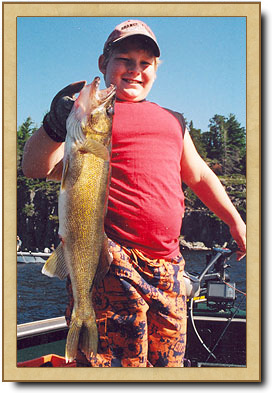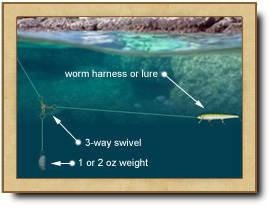|
Walleye Fishing Tips for Eagle Lake:
Spring: In the spring the Walleyes are easy to catch. In the day the big females take off into deeper water but the males will hang around the spawning beds. Usually the prime spawning grounds are at the mouth of feeder streams, sand bars, sandy points and sometimes gravel areas. The Walleye are shallow in the spring. In the day male Walleyes might back off into 3 or 4-feet deep of water and not far from the spawning beds but in the evening they are right back up into 1 to 3 feet deep of water. This means you are fishing a couple of feet from shore and not out in the open lake. We cannot stress that fact more. If you want spring Walleye, fish the shoreline or mouth of streams. In the evening the big females will come back to the spawning area for a few days after spawning but don't stick around as long as the males.
You can fish with light jigs and twistertails. White Twistertails are always the best but in the spring the Walleyes are more aggressive and will hit obnoxious colors like chartreuse, pink, yellow or orange. These colors only work in the spring because the Walleyes are hitting them to defend their spawning grounds and not for feeding. You can also add a leach, worm, minnow or Walleye Gullet to the jig to get more action but it's usually not needed.
|

|
If you want to catch a trophy Walleye in the spring, which will most certainly be a female, try casting towards shore or better yet, troll very slowly at night along the shore with a small Original Floating Rapala or Junior Thunder Stick. Red, Fire-Tiger and Blue are the best colors in the spring.
Summer: Summer is a mixed bag of behavior from the Walleyes. Some stay shallow and hide in thick weeds or hang around rocky points. Some go deep and others take off into open water and stay suspended around 15 feet down and feed on suspended schools of baitfish.
In thick weeds or off rocky points, fish with 1/8 to 1/4 oz jigs and white twistertails. You can put a small minnow or worm on the jig to motivate the Walleyes when it's warm and sunny and they have slowed down. The very best bait is to put a tiny piece of Walleye gullet on the jig.

|
In the summer, the bigger Walleyes go deep during the day. They can still be taken in the early morning or late evening close to shore but during the day, try trolling really slow with a 3-way swivel rig and a worm harness. 15 feet deep is a good place to start. Some of the really big females will even go deeper. Trolling along deep drop-offs or deep weed beds is also an excellent place to try. Trolling deep for Walleyes is something very few people do. If more people tried fishing deep with a 3-way swivel rig, 10-pound Walleyes and bigger would seem a lot more common. The big trophy Walleyes do not like shallow water like the smaller ones.
|
Some of the bigger Walleyes will head out to open water to feed on suspended schools of baitfish. Find a deep hole, which is not too far from a weedy bay, rocky point or feeder stream and try trolling 10 to 15 feet deep with Husky Jerks or other lures that will go a little deeper.
Fall: Fall is a good time of year to fish for Walleyes if you fish in the right areas. This time of year the weeds start to die and as they decompose, they absorb oxygen out of the water. The Walleyes will tend to find places where there is more oxygen. Try fishing at the mouth of a stream or right up in the current. They will also move to rocky shorelines and rocky points that face the open lake and get the most wave action. Waves hitting shore will produce oxygen in the water. Other Walleyes that like the thick weeds during the summer will move off into deeper water just off the weeds beds or at least stay at the outer edge of the weeds. This gives them more fresh water but still gives them some cover.
In the fall, Walleyes become hypersensitive to changes in pressure and weather. It can be the best time for Walleyes and the worst time for Walleyes. You can go two days without catching a Walleye and on the third day you can see the best Walleye fishing you have ever seen. If the pressure starts to drop, the Walleyes may stop feeding. Once the pressure reaches rock bottom, they will start feeding and then feed very well while the pressure is rising. Once the pressure gets high, they may stop feeding again. This is not carved in stone. Sometimes the Walleyes feed better as the pressure starts dropping and the weather becomes miserable. You just have to be out there and don't stop trying.
Scent: You will maximize the amount of fish you catch if you try your hardest to keep your hands clean of gas smell or soaps. The best thing to do is wash your hands with unscented soap and then wash them a second time using your fish scent.
